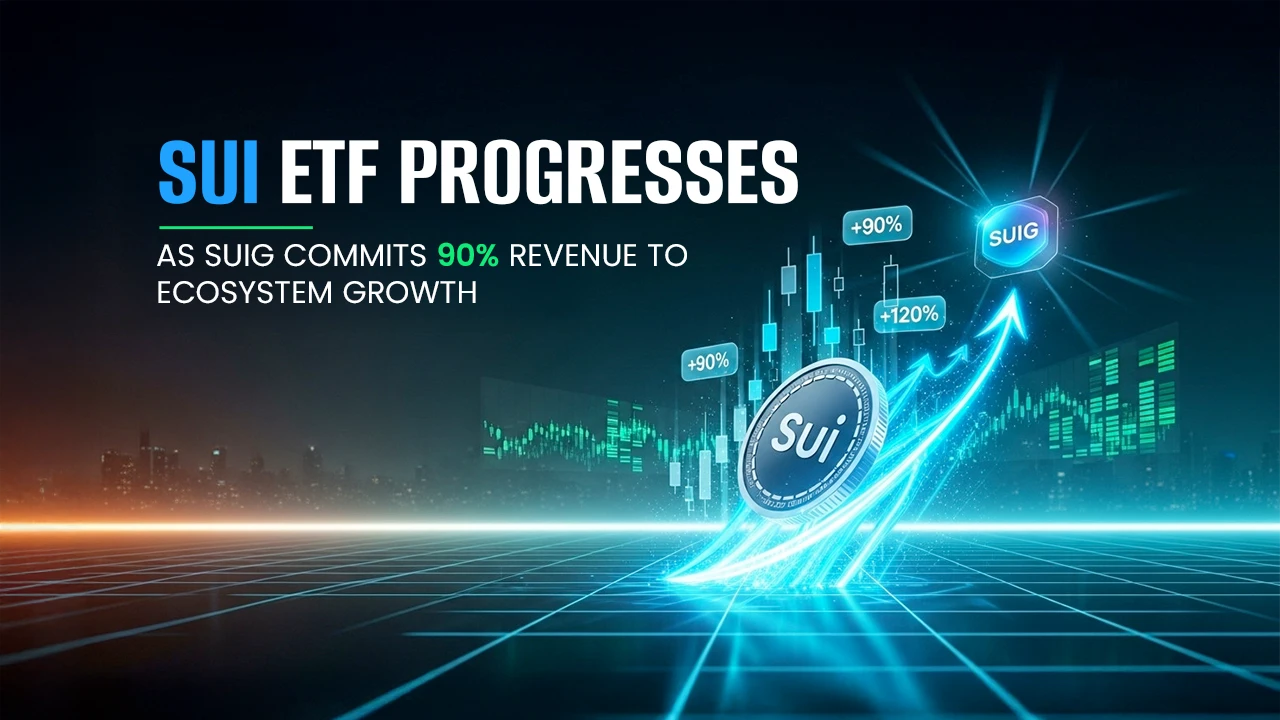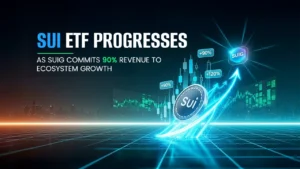Sui ETF Back in Limelight as Cboe Awaits SEC Decision on Canary ETF

Sui ETF is back in the conversation after two converging catalysts. Canary Funds advanced procedural steps for a U.S. spot Sui exchange-traded fund, while SUIG outlined a plan to reinvest revenue in the Sui ecosystem. The filing activity adds structure to a long regulatory process. The growth roadmap signals on-chain execution in parallel. Together, these developments arrive days after a market shock that sliced prices across majors and large-cap altcoins.
- Canary’s Sui ETF Filing Moves Ahead, With Administrative Updates
- SUIG’s Growth Strategy Puts Cash Back Into Developers
- Price Action Since October 10: A Recovery With Work To Do
- For Sui ETF Investors: What To Track From Here
- Key Milestones And Reference Points
- Conclusion
- Frequently Asked Questions About SUI ETF Filing Update and SUIG’s Growth Strategy
- How close is the Sui ETF to approval?
- Would a Sui ETF hold SUI directly?
- What role does DPoS play for Sui ETF investors?
- What is SUIG planning to fund?
- Did Sui’s price fully recover from the October 10 drop?
- Where can I read primary sources?
- Glossary Of Key Terms
Sui’s rebound since October 10 stands out as liquidity normalizes and investors revisit fundamentals anchored in Delegated Proof of Stake. Sui uses a DPoS design where token holders delegate stake to validators, and rewards flow based on fees and performance. That model remains a core part of the project’s value story and informs staking, governance, and throughput expectations.
ALSO READ: TRON Staking Goes Live on Ledger Live, Self-Custody Rewards Finally One Tap Away
This news article examines the changes in the Sui ETF paperwork, SUIG’s intended development, and how price action aligns with on-chain metrics. It also frames what investors should watch next, from Cboe filings to SEC timelines. The aim is clarity for portfolio decisions, not forecasts. Where relevant, we link to primary materials.
Canary’s Sui ETF Filing Moves Ahead, With Administrative Updates
Canary Funds filed an S-1/A amendment for its proposed spot Sui ETF. The update is administrative. It adds a Cboe ticker reference and updates the sponsor’s address. It does not alter fees, risk factors, or financial terms, according to coverage that reviewed the filing. Administrative moves of this type usually precede the next review steps rather than resolve policy questions. The SEC still has to decide on both exchange listing rules and the registration statement.
Cboe BZX, the exchange that would list the product, previously filed a 19b-4 rule change to permit trading of the trust shares. That filing is visible on Cboe’s rule-filings portal and is part of the dual-track process the SEC follows for spot crypto products. The exchange filing tees up the market-structure side, while the S-1 handles disclosures and the sponsor’s responsibilities. Both must be approved.
Earlier this year, Reuters reported Canary’s Sui proposal among a broader wave of crypto ETFs pursuing U.S. approval under the current administration. Optimism rose following leadership changes and policy signals, but the SEC retains discretion over timing. The Sui ETF would be the first for this asset if cleared. The product would give regulated exposure to a Layer-1 that runs on Delegated Proof of Stake, a point the sponsor and the community emphasize when discussing suitability for traditional wrappers.
MartyParty highlighted the S-1/A update and Cboe ticker addition, underscoring that no risk or fee sections changed.
$SUI ETF News: @CanaryFunds files an S-1/A amendment #1 to their Spot SUI ETF with the SEC.@SuiNetwork
Changes:
– Address change.
– Ticker symbol added to @Cboe
– No financial term changes.
– No changes in risk factors.https://t.co/9E1IT0qHO2(Results from the LQL SEC… pic.twitter.com/Vgv9dDh5hm
— MartyParty (@martypartymusic) October 17, 2025
SUIG’s Growth Strategy Puts Cash Back Into Developers
In parallel with the filing update, SUIG communicated an expansion plan that includes a proposed “SUI Bank” concept and a pledge to reinvest a large share of revenue into the ecosystem. Reported details suggest a reinvestment ratio near 90 percent routed via stablecoins and development funding, positioning SUIG as a growth engine for dApps, tooling, and user-onboarding services on Sui. The plan aims to institutionalize support for builders and liquidity while preserving transparent treasury mechanics. Coverage also cited work on product rollouts tied to Sui’s DeFi stack.
The sequencing matters for investors. ETF news can pull in attention, but on-chain traction must keep it. A reinvestment model can create durable demand for blockspace if it stimulates real usage. The strategy fits a broader push to highlight Sui’s fee model, object-centric architecture, and validator economics within a DPoS framework. Delegation concentrates voting power with performant validators, and rewards align around gas fees and storage usage. That link between activity, fees, and rewards becomes more important if ETF-driven flows arrive later.
ALSO READ: Sui DEX Volume Hits ATH Amid Typus Exploit, SEC’s Green Signal to YLDS
Price Action Since October 10: A Recovery With Work To Do
The market shock on October 10 produced extreme intraday moves. Axios documented a broad deleveraging after a tariff tweet, with Sui among the hardest-hit altcoins during the cascade. Liquidity returned in the following days. Subsequent reporting noted Sui’s rebound toward the mid-$2 range as spot volumes improved and volatility cooled. Technical commentary pointed to a former ascending trendline now acting as resistance, a reminder that supply overhang remains after sharp drawdowns. Professional desks will watch whether Sui can hold higher lows and reclaim former ranges as ETF headlines cycle.
ETF narratives can move flows. They also compress time horizons for traders. Investors with longer views will weigh DPoS staking yields, validator set health, and application growth over headline cadence. Those fundamentals typically have steady drawdowns and support recoveries if usage persists.
For Sui ETF Investors: What To Track From Here
Three tracks deserve attention. First, the rule-making path at Cboe BZX and the SEC’s docket. Exchange rule approvals and S-1 comments signal where the product sits in the queue. Second, SUIG execution and treasury transparency. Reinvestment claims need measurable outputs, such as funded grants, audited disbursements, and product launches. Third, on-chain health under DPoS. Monitor validator concentration, stake distribution, epoch rewards, and how gas revenue trends as dApps scale. These signals help separate headline rallies from durable adoption.
ALSO READ: ARK Invest Rolls Out Space-Defense ETF in Europe as XDC Network Makes Headway in Dubai
A fourth track is macro. The October 10 event showed how a single policy-linked tweet can overwhelm micro drivers. Position sizing and risk limits matter more when policy is volatile. ETF approvals, if they come, would not eliminate that risk. They could, however, broaden access and deepen liquidity.
Key Milestones And Reference Points
| Item | Date | What Changed | Why It Matters |
| Cboe BZX 19b-4 filing visible | April 2025 | Exchange proposal to list and trade shares of a Sui commodity-based trust | Establishes market-structure path that must be approved alongside the S-1. |
| Canary announces Sui ETF proposal | March 17, 2025 | Reuters reports Sui ETF among Canary’s filings list | Confirms sponsor intent and expands the ETF roster beyond BTC and ETH. |
| S-1/A administrative update | October 17–20, 2025 | Address and ticker updates, no risk or fee changes | Suggests continued progress through SEC review logistics. |
| Market shock and Sui drawdown | October 10, 2025 | Broad liquidation after tariff tweet, Sui hit hard | Sets the context for subsequent rebound and resistance levels. |
| Price recovery coverage | October 20, 2025 | Reports cite Sui near mid-$2 with trendline resistance | Frames the near-term technical picture for investors. |
Conclusion
Sui ETF’s week features two distinct signals. Canary’s S-1/A amendment advances the ETF application through necessary logistics. SUIG’s roadmap emphasizes reinvestment and product development. The former is about access and market structure. The latter is about usage and retention. Both are relevant for institutional and retail investors who prefer clear frameworks and verifiable progress.
Sui’s Delegated Proof of Stake or DPoS model remains a consistent anchor in the narrative, aligning validator incentives with activity and offering a familiar mechanism for staking and governance. If decision makers approve a spot Sui ETF, regulated access could broaden the investor base. If SUIG executes on its reinvestment plan, on-chain usage could deepen liquidity and fees.
The combination would not immunize Sui from macro shocks, as October 10 showed, but it would give the asset a clearer path to fundamental support when markets settle. The next checkpoints are SEC updates on exchange rule filings, S-1 comments, and transparent SUIG progress reports that match stated reinvestment targets.
Frequently Asked Questions About SUI ETF Filing Update and SUIG’s Growth Strategy
How close is the Sui ETF to approval?
Approval requires both a rule change for the exchange and an effective registration statement. Cboe filed the rule proposal earlier, and Canary filed an S-1/A with administrative updates. No final approval has been granted. Timelines remain at the SEC’s discretion.
Would a Sui ETF hold SUI directly?
The proposal is for a spot product that reflects Sui’s market price through holdings of the underlying asset. The trust’s structure is defined in the registration documents and will be reviewed by the SEC before any approval.
What role does DPoS play for Sui ETF investors?
DPoS shapes validator selection, rewards, and governance. Holders can delegate stake to validators and earn rewards from gas fees. This mechanic supports security and aligns incentives with network usage.
What is SUIG planning to fund?
Reported plans include a “SUI Bank” concept and reinvestment of most revenue into development, liquidity, and ecosystem growth. Investors should seek transparent reporting and measurable outcomes.
Did Sui’s price fully recover from the October 10 drop?
Coverage shows a rebound toward the mid-$2 area, though former trendlines now act as resistance. Market conditions and liquidity will drive whether the asset reclaims prior ranges.
Where can I read primary sources?
Investors can review Cboe’s rule-filings page, Sui’s staking documentation, and third-party reporting on the ETF filings. We link to these sources throughout this Sui ETF article.
Glossary Of Key Terms
- S-1/A: An amended registration statement filed with the SEC for securities offerings.
- 19b-4: A rule-change filing that exchanges submit to the SEC to list new products.
- Spot ETF: An exchange-traded fund that holds the underlying asset to reflect its market price.
- Cboe BZX: A U.S. equities exchange that lists ETFs and submits related rule changes.
- DPoS: Delegated Proof of Stake, a consensus model where token holders delegate stake to validators.
- Validator: A node that participates in consensus and earns rewards for processing transactions.
- Gas Fees: Transaction fees paid to validators for executing and finalizing transactions.
- Epoch: A discrete period after which staking rewards are distributed on networks like Sui.
- Trendline Resistance: A technical level where price meets selling interest after a rebound.
- Treasury Reinvestment: A policy to direct a portion of revenue back into ecosystem development.




